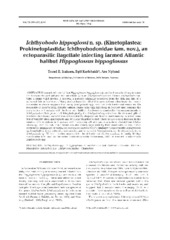Ichthyobodo hippoglossin. sp. (Kinetoplastea: Prokinetoplastida: Ichthyobodonidae fam. nov.), an ectoparasitic flagellate infecting farmed Atlantic halibut Hippoglossus hippoglossus
Peer reviewed, Journal article
Published version
Permanent lenke
https://hdl.handle.net/1956/6377Utgivelsesdato
2007-01-18Metadata
Vis full innførselSamlinger
Sammendrag
Diseased Atlantic halibut Hippoglossus hippoglossus juveniles from a hatchery in western Norway showed gill and skin infections with an Ichthyobodo species. Genus Ichthyobodo contains a single valid species, I. necator, a parasite originally described from the skin and fins of a salmonid fish in freshwater. Many studies have identified this species from other hosts, but recent molecular evidence suggests that many Ichthyobodo spp. occur in both fresh- and seawater. We redescribe I. necator from Atlantic salmon Salmo salar skin infections in Norway and compare the morphology of I. necator with the form from halibut. A scheme to standardise the measurements of Ichthyobodo cells is presented. Morphologically, the Ichthyobodo species from the skin and gills of halibut differs from I. necato1 from salmon skin by shape (in air dried stained smears), by a low num ber of variably sized kinetoplasts and by a long flagellar pocket. There is also a clear increase in the number of kinetoplasts in I. necator with increasing cell size (area). a pattern absent from Jchthy obodo sp. from halibut. The 2 forms are also clearly separated by their small subunit (ssu) rONA sequences; alignments of partial ssu sequences showed 93.5% similarity. Conseq uently, Ichthyobodo sp. from halibut is considered a new species, and is named I. hippoglossi n. sp. Its closest relative is Ichthyobodo sp. IV from another marine fish, the Atlantic cod Gadus morhua. A family, lchthy obodonidae fam. nov. in the order Prokinetoplastida Vickerman, 2004, is erected to encompass Ichth yobodo spp.
